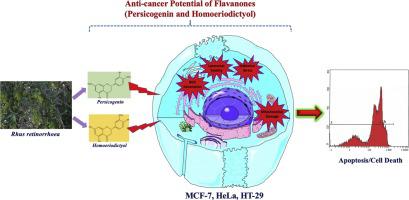当前位置:
X-MOL 学术
›
Process Biochem.
›
论文详情
Our official English website, www.x-mol.net, welcomes your
feedback! (Note: you will need to create a separate account there.)
Anticancer efficacies of persicogenin and homoeriodictyol isolated from Rhus retinorrhoea
Process Biochemistry ( IF 3.7 ) Pub Date : 2020-08-01 , DOI: 10.1016/j.procbio.2020.02.008 Quaiser Saquib , Sarfaraz Ahmed , Mohammad S. Ahmad , Adnan J. Al-Rehaily , Maqsood A. Siddiqui , Mohammad Faisal , Javed Ahmad , Asma N. Alsaleh , Abdulrahman A. Alatar , Abdulaziz A. Al-Khedhairy
Process Biochemistry ( IF 3.7 ) Pub Date : 2020-08-01 , DOI: 10.1016/j.procbio.2020.02.008 Quaiser Saquib , Sarfaraz Ahmed , Mohammad S. Ahmad , Adnan J. Al-Rehaily , Maqsood A. Siddiqui , Mohammad Faisal , Javed Ahmad , Asma N. Alsaleh , Abdulrahman A. Alatar , Abdulaziz A. Al-Khedhairy

|
Abstract Herein we examined two flavanones (persicogenin and homoeriodictyol) isolated from Rhus retinorrhoea to elucidate the mechanism of their anticancer effects in MCF-7, HeLa, and HT-29 cells. Based on the [3-(4,5-dimethylthiazol-2-yl)-2,5-diphenyltetrazolium bromide)] (MTT) cytotoxicity data of persicogenin (500 μg/ml) caused a 58.1 % reduction in HT-29 survival while homoeriodictyol (500 μg/ml) caused a 51.9 %, 66.7 % and 76.2 % reductions in MCF-7, HeLa and HT-29 cell survival, respectively. The neutral red uptake (NRU) assay revealed 53.6 %, 53.9 %, 58.8 % and 83.0 %, 87.7 %, 66.7 % reductions in MCF-7, HeLa, and HT-29 cell survival following persicogenin and homoeriodictyol (500 μg/ml) treatment, respectively. Moreover, the intracellular reactive oxygen species (ROS) was significantly enhanced and dysfunction of mitochondrial membrane potential (ΔΨm) confirmed the mitochondrial injury in all cell types by the flavanones. MCF-7, HeLa, and HT-29 cells exposed to persicogenin and homoeriodictyol (500 μg/ml) had showed 42.5 %, 63.1 %, 62.3 % and 30.7 %, 30.2 %, 23.8 % cells in the sub G1 apoptotic phase. The persicogenin- and homoeriodictyol-treated cell lines had upregulated expressions of p53, caspase-3, caspase-9, bax, and superoxide dismutase 1 (SOD1) genes. Such findings provide novel insight into the comparative anti-cancer efficacy of persicogenin and homoeriodictyol, signifying their promising clinical applications as cancer treatments and their application as bioactive therapeutic agents.
中文翻译:

从漆树中分离的persicogenin和高圣草醇的抗癌作用
摘要 在此,我们检测了从 Rhus retinorrhoea 中分离的两种黄烷酮(persicogenin 和 homoeriodictyol),以阐明它们在 MCF-7、HeLa 和 HT-29 细胞中的抗癌作用机制。根据 [3-(4,5-二甲基噻唑-2-基)-2,5-二苯基溴化四唑)] (MTT) 的细胞毒性数据,persicogenin (500 μg/ml) 导致 HT-29 存活率降低 58.1%,同时高圣草醇 (500 μg/ml) 分别导致 MCF-7、HeLa 和 HT-29 细胞存活率降低 51.9%、66.7% 和 76.2%。中性红吸收 (NRU) 分析显示,在使用 persicogenin 和高山梨醇 (500 μg) 后,MCF-7、HeLa 和 HT-29 细胞存活率分别降低了 53.6 %、53.9 %、58.8 % 和 83.0 %、87.7 %、66.7 %分别治疗。而且,细胞内活性氧(ROS)显着增强,线粒体膜电位(ΔΨm)功能障碍证实了黄烷酮对所有细胞类型的线粒体损伤。MCF-7、HeLa 和 HT-29 细胞暴露于 persicogenin 和高香茅醇 (500 μg/ml),在亚 G1 期细胞凋亡率分别为 42.5%、63.1%、62.3% 和 30.7%、30.2%、23.8% persicogenin 和高圣草醇处理的细胞系 p53、caspase-3、caspase-9、bax 和超氧化物歧化酶 1 (SOD1) 基因的表达上调。这些发现提供了对 persicogenin 和高圣草醇的抗癌功效的比较新见解,表明它们作为癌症治疗的有希望的临床应用和它们作为生物活性治疗剂的应用。
更新日期:2020-08-01
中文翻译:

从漆树中分离的persicogenin和高圣草醇的抗癌作用
摘要 在此,我们检测了从 Rhus retinorrhoea 中分离的两种黄烷酮(persicogenin 和 homoeriodictyol),以阐明它们在 MCF-7、HeLa 和 HT-29 细胞中的抗癌作用机制。根据 [3-(4,5-二甲基噻唑-2-基)-2,5-二苯基溴化四唑)] (MTT) 的细胞毒性数据,persicogenin (500 μg/ml) 导致 HT-29 存活率降低 58.1%,同时高圣草醇 (500 μg/ml) 分别导致 MCF-7、HeLa 和 HT-29 细胞存活率降低 51.9%、66.7% 和 76.2%。中性红吸收 (NRU) 分析显示,在使用 persicogenin 和高山梨醇 (500 μg) 后,MCF-7、HeLa 和 HT-29 细胞存活率分别降低了 53.6 %、53.9 %、58.8 % 和 83.0 %、87.7 %、66.7 %分别治疗。而且,细胞内活性氧(ROS)显着增强,线粒体膜电位(ΔΨm)功能障碍证实了黄烷酮对所有细胞类型的线粒体损伤。MCF-7、HeLa 和 HT-29 细胞暴露于 persicogenin 和高香茅醇 (500 μg/ml),在亚 G1 期细胞凋亡率分别为 42.5%、63.1%、62.3% 和 30.7%、30.2%、23.8% persicogenin 和高圣草醇处理的细胞系 p53、caspase-3、caspase-9、bax 和超氧化物歧化酶 1 (SOD1) 基因的表达上调。这些发现提供了对 persicogenin 和高圣草醇的抗癌功效的比较新见解,表明它们作为癌症治疗的有希望的临床应用和它们作为生物活性治疗剂的应用。






























 京公网安备 11010802027423号
京公网安备 11010802027423号